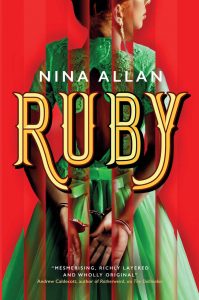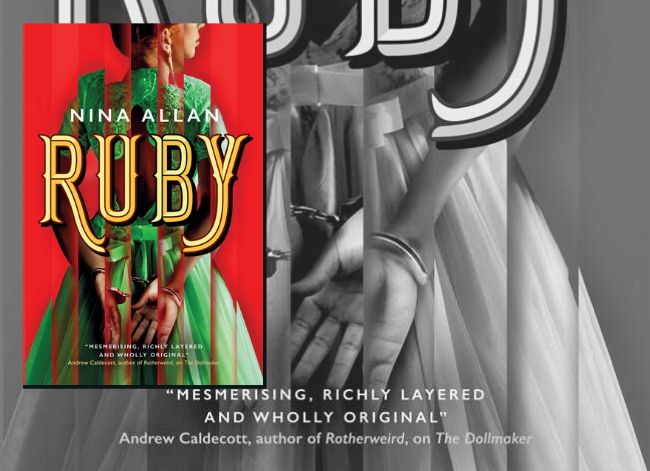Ruby (2020) by Nina Allan — Book Review
The problem with having a story is that everyone starts believing they know it by heart.
Sometimes the life you need turns out to be different from the life you wanted.
 Nina Allan’s Stardust: The Ruby Castle Stories was published in 2013 by PS Publishing, shortly before her novel The Race was published to great acclaim by NewCon Press in 2014. This year, Titan has reissued a revised and expanded version of Stardust, retitled Ruby. As with Titan’s expanded edition of The Silver Wind (2019), this reissue not only makes a vital early chapter of one of our most exciting and vital authors widely available, it has allowed Allan to return to an earlier work with the benefits of her mature talent and present us with a more complete and satisfying version.
Nina Allan’s Stardust: The Ruby Castle Stories was published in 2013 by PS Publishing, shortly before her novel The Race was published to great acclaim by NewCon Press in 2014. This year, Titan has reissued a revised and expanded version of Stardust, retitled Ruby. As with Titan’s expanded edition of The Silver Wind (2019), this reissue not only makes a vital early chapter of one of our most exciting and vital authors widely available, it has allowed Allan to return to an earlier work with the benefits of her mature talent and present us with a more complete and satisfying version.
Stardust, like The Silver Wind: Four Stories of Time Disrupted (2011), was originally published as a collection of linked short stories, but can more productively be read as a novel with a fractured narrative. Ruby does not contain as much new and reworked material as the Titan edition of The Silver Wind – which I shall write about later – but, similarly, the changes in the Titan edition emphasise the thematic links between the material without compromising Allan’s visions of shifting realities and alternate perspectives. Ruby shares, along with Allan’s other works (the wonderful novels The Race, The Rift (2017) and The Dollmaker (2019)), a fascination with the nature and the form of storytelling, the distorting effect perspective has on narrative, the way in which telling a story shapes the subject matter. The seven stories in Ruby are individually powerful pieces of contemporary Weird fiction that range across time and subject matter, and offer an example of Allan’s range and command of the form. However, they are all linked by the figure of Ruby Castle, a glamourous horror film actor who was jailed for the murder of her co-star and lover.
Ruby haunts the peripheries of these stories, a phantasmal presence signalling a break between congruent realities as much as an implied connection between disparate stories and characters. In ‘B-Side’ she is the star of the horror films that Michael enjoys in between chess tournaments and school. In ‘The Lammas Worm’ she is the assistant to a knife thrower at a circus that picks up a mysterious woman at the roadside outside of Cirencester, a circus whose funhouse, constructed by the mysterious Gelb brothers, acts as a portal to the future through which a child is lost in ‘Gateway’. During her time in prison she becomes the muse of the poet Matthew Clearly, causing him to leave his wife and children and surrender to his art in ‘The Red Queen’, but leaving him a lonely old man only cared for by his ghost-haunted friend Christine in ‘Laburnums’. In ‘Stardust’ she flickers on the screen in the house of Alina Maslanyi, sister of chess grandmaster Nick Maslanyi who is idolised by Michael’s chess teacher in ‘B-side’, on the day of the dual disaster of the Anastasia space disaster and the murder of her grandmother in near future post-second Cold War Russia. She appears as a mysterious figure in a dream and a painting, linking Vernon’s estranged wife with Charlie’s painter uncle in ‘Wreck of the Julia’. Throughout these entangled narratives, Ruby the woman becomes obscured by what Ruby the image means to the various characters. Whether on or off-screen, or in the interstices where dream and reality overlap, Ruby’s glamour is a performance that has taken over from the performer.
As well as Ruby, the stories share a sense of unease and the uncanny. This is amplified by the oblique way they each connect. Throughout dreams and fantasies, films and performances, futures and pasts, pulling together all the connections between the different stories only serves to add to the confusion. Major characters in one story are reprised as minor ones in other pieces, forming a ripple pattern across time and space rather than a linear narrative. This is reflected in the subject matter of the stories themselves, which frequently focus on dreams leaking into reality. In ‘B-Side’, Michael encounters sinister characters who appear to have walked out of the Ruby Castle films he loves whilst going home at night. Vernon in ‘Wreck of the Julia’ finds his recurring nightmare given form in the painting of the title, which itself turns into a dismal warning of a nightmarish encounter in a primal forest. The nightmarish world in which Andrew loses Claudia in ‘Gateway’ is the small German town’s future as a concentration camp during World War II. In ‘Stardust’, Alina encounters the dead astronauts killed in the explosion of the Anastasia in a carriage in a train, though whether this vision or the orchestrated TV spectacle of the space disaster is the dream remains uncertain. The stories demonstrate Allan’s ability to get under the reader’s skin, to create utterly convincing lived lives for her characters then to pull gently at the seams to expose the confront them with the constructed nature of their realities.
As with all of Allan’s work, underlying it all is a deep love for the power of storytelling, and a relentless curiosity to explore what telling stories means. The characters in Ruby are all caught within their own webs of lies, half-truths and constructed fantasies, and Allan pushes them to the point where their worlds constructed of words fall apart beneath them. The stories display Allan’s love for the Weird as a medium for storytelling, and a fascination with how recontextualising these characters and images across different modes of the Weird changes the structure and nature of these stories. Readers will recongise elements of science fiction, folk horror and ghost stories, all of which Allan uses in fresh and unsurprising ways. As such Ruby is not just a story about the power of narrative perception to distort, but a tribute to how genre fiction shapes the stories we tell. Ruby is essential reading for fans of Allan’s writing and those with an interest in the Weird. It is a pleasure to read it in its revised and expanded form, released to a wider audience.

